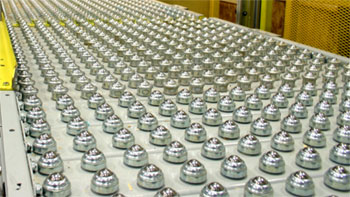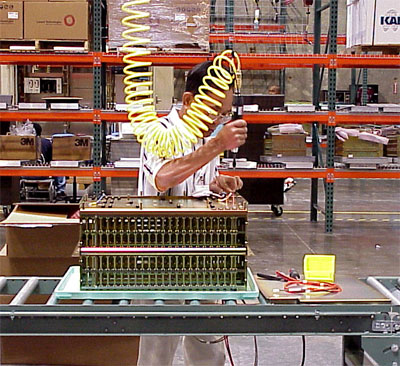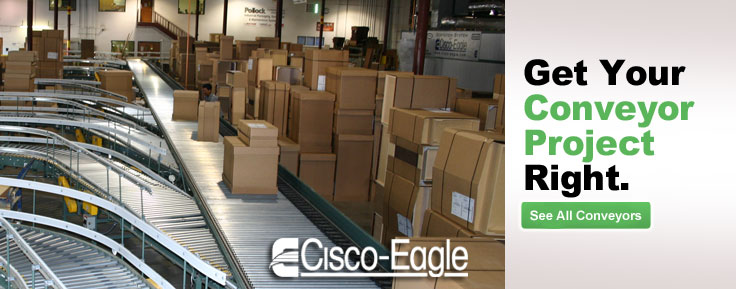How to Use Conveyors to Increase Warehouse Ergonomics
Conveyors help reduce manual lifting, along with injuries from strains and reaching—if you design and implement them correctly

Conveyors are ergonomic equipment by nature. They reduce manual lifting, pushing, pulling and stretching by delivering product to workers and reducing the stress of carrying or pushing it manually. Whether in a large integrated system or a spur of gravity, conveyors are great for reducing the number of people who engage in potentially dangerous activities that could cause musculoskeletal issues. Let’s dive into ways to be sure your conveyors are contributing to an ergonomic operation.
The ergonomics of using conveyors
Let the conveyor do as much of the shifting, movement, rotation and other product positioning as possible

Workers should not need to re-position conveyed product when it reaches them
Here are some methods for reducing manual handling on a conveyor line.

- Utilize ball transfers or turntable lifts to allow easy positioning for work.
- Use tapered rollers to move the load from the center of the conveyor to the work side.
- Use diverts or pushers to move product to the right position for ergonomic work.
- Have your conveyor feed a rotating table, which can be made with flat tops or rollers depending on the situation.
- Use ball transfers to allow workers to rotate loads on the conveyor without straining themselves or reaching too far.
Consider the benefits of providing the load at the correct position over hundreds of days, multiple shifts and many workers. Each unit may take less time to process (pick, pack or execute work on), resulting in fewer chances for error or injury and a generally faster process.

Use spirals, chutes and inclines to move loads between levels
If the items need to convey down from an elevated conveyor or platform, utilize chutes or decline belt conveyors to deliver them to floor level. Chutes and spirals consume the least space, but inclines are also fine for many situations. When the conveyor delivers the load, its height should ensure that your operators’ hands are about 30″ from the ground (see conveyor heights below). Operators should not have to reach into the chute to move loads, which should flow freely to the ground level.
These guidelines also apply to the top of a mezzanine or platform, where it’s important to place loads within easy reach of workers as they arrive.
Utilize gravity conveyors to handle items that could be moved by hand
There are places where a worker could take a case from storage and walk it to a secondary location or workstation. If possible, use gravity conveyors to deliver it so that the load isn’t being needlessly hand-carried. There are plenty of ways to use inexpensive gravity conveyors to remove or reduce manual handling. Be sure the loads are lightweight enough that people don’t strain to move them on the conveyor. This is ideal for downhill runs.
Use portable conveyors that can be moved into position wherever needed

Portable conveyors like skatewheel sections on casters or flexible conveyor are good for ergonomics, since you can position them at the point of work to reduce the amount of manual handling. This flexibility is often useful at shipping or receiving docks, where these solutions can adapt to needs as they arise. It’s very easy to move these conveyors to points where workers might otherwise handle loads manually.
Convey pallets rather than other movement methods
People shouldn’t be routinely moving full pallets by muscle power—even on pallet jacks. Pallet jacks are fine for point-to-point applications that vary, but if the pallet is being moved through a facility consistently, conveyors are much more ergonomic than relying on muscle power. Floor mounted conveyors are an excellent way to transport larger or palletized loads between workstations. The conveyor allows workers to easily work around it without the typical stresses or strains of dealing with these types of items. Also, the conveyor can be set to raise or lower the pallet with the correct equipment and design.
Set conveyor height to match average vertical knuckle position

Conveyor supports are adjustable, but usually can’t be adjusted easily on the fly, so it’s important to set your height so that it minimizes bending over to access the load.
Let’s talk about knuckle heights. Ideally, the load should sit at the vertical distance from the floor to the center of the operator’s hands. On average, this is about 30″, which is why the most common conveyor supports (when added to bed heights) are around this height. However, given that it’s easy to have more than a foot of height difference between workers, there isn’t any clear solution.
Some options with knuckle heights:
- Set the conveyor at average height (30″ as mentioned). This fits most of the people most of the time.
- Set the conveyor height for the 75th percentile knuckle height. Shorter workers would have the loads somewhere between knuckle and elbow height. This means fewer people would need to bend to access loads on the belt or rollers.
- Set the conveyor height for the tallest workers. In this scenario, nobody has to bend to access a load, but shorter workers would have to use portable work platforms. The 95th percentile male knuckle height is 32″. These individuals could use the conveyor easily. The few above that height would have to bend less than 20 degrees, while shorter workers might need platforms to reach the loads ergonomically.
Be aware of load heights. If you are picking totes that are mostly in the same size range, it’s easier to deal with than a series of cartons that are all different heights. Understanding your load variety helps you specify the right conveyor height, but the general advice from ergonomic experts is to focus on your most frequently handled box sizes if this is the case.
Resources:
- NIOSH: Manual Material Handling (PDF)
- 5 Proven Benefits of Workplace Ergonomics
- The Ergonomic Design of Conveyor Workstations
Tags: ergonomics, Safety & Ergonomics
Scott Stone is Cisco-Eagle's Vice President of Marketing with 35 years of experience in material handling, warehousing and industrial operations. His work is published in multiple industry journals an websites on a variety of warehousing topics. He writes about automation, warehousing, safety, manufacturing and other areas of concern for industrial operations and those who operate them.




